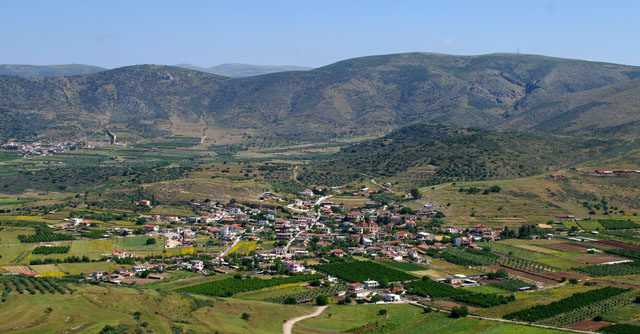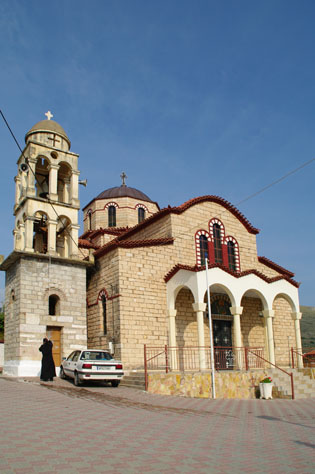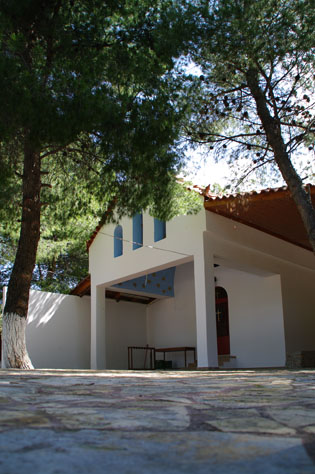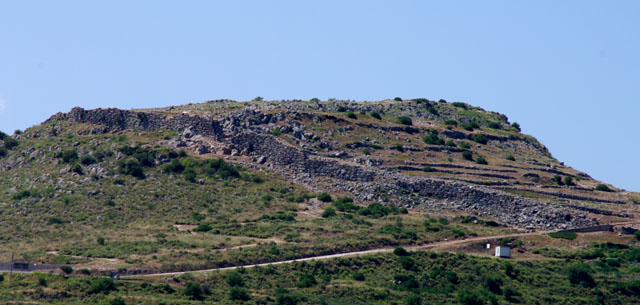Midea
| Midea is located on the northeastern end of the Argolida plain. It is 14 km away from Argos and 12 km from Nafplio. It is connected to the national and provincial road network of the area with paved roads, making the access to the village problem-free, and road markings are simultaneously good. The village is built at an altitude of 130 meters. It has a southern orientation (note that the view of the whole settlement is amazing) and it is distinguished for the mildness and dryness of its climate. The inhabitants are mainly engaged in agriculture and less in farming. The place produces vegetables, citrus, olive and other fruits of high quality. |
||
 |
||
| Panoramic view of Midea | ||
|
The village was called until 1928 officially Gkermpesi. Gkermpesi as name of region appears in Venice bibliographic records of the late 17th - early 18th century, where together with other villages of the municipality "the village Plataniti and its manors, Manesi, Dendra Bardi, Gkermpesi, Kalivia, Marianos and their territory", make up one of the 29 real estate regions that make up the region Nafplio. (Zevgolatio means little manor). In the early 19th century Gkermpesi seems to belong to the vilayet of Argos according to tax records file of Perouka. The residents of the village in 1829 were only 55, according to the census that made the French Expeditionary Corps. Today (2011) the settlement of Midea along with the neighbouring village of Amygdalitsa has about 630 residents. The settlement of Amygdalitsa (the original name was Bardi) is located at an altitude of 200 meters with excellent view over the plain of Argolida. The inhabitants are engaged in agriculture and animal husbandry. The village celebrates the Life Giving Fountain. Both settlements inhabited by Arvantitics who were Christians and spoke their own language, which is current language of current older residents and less of younger inhabitants. |
||
 |
||
| View of the village square |
||
|
In the village, two Associations operate, the Association of highlighting and promoting Antiquities of the Mycenaean Acropolis of Midea, and the Association of (residents of Gkermpesi) "Midea", with rich cultural activities. The following events are made at the village by the Association of Midea: a) On the last Sunday of Carnival traditions of Carnival are rivivingb) At the end of June the celebration of Giossa (special food consisted of ewe grilled for many hours in wood-stove) c) A three-day cultural event in August. The village has three temples: this of St. John, which is celebrated on May 8, of Saint John, celebrated on August 29 and that of St. Anargyroi celebrated on July 1. |
||
  |
||
| Church of St. John - Central Church of Midea Church of St. Jon Theologian | ||
|
The visitors can wander through the streets of the village depending on the season of smell delicious flowers that are planted in the courtyards of the houses, he can also go to the chapel of St. John by car or on foot for 45 minutes, where he will be "compensated" by the view entire Argolida's plain to the sea. More information about St. John the Theologian can be found in the "Archaeological Sites - Points of Interest". |
||
|
Of course no one must omit a visit to the Mycenaean Acropolis (more information about the Mycenaean Acropolis can be found in the "Archaeological Sites - Points of Interest") with panoramic view of the plain of Argos, icluding its castle (Larissa), the beach and Palamidi castle of Nafplio. The Acropolis of Midea is one of the most remarkable fortifications Mycenaean ages. |
||
 |
||
| View of the Acropolis of Midea | ||
|
The visitor of Midea can also pass the gorge of Honi (Karababa) from the foot of Arachnaio (Amarianos) to the Abbey of Talantio, at the plateau of the village Arachnaio. Finally, anyone tired of the long tour can enjoy the famous giossa (a kind of lamp), the goges (a kind of pasta) and other traditional foods in the taverns of the village. St. John - Central Church of Midea (Lat: 37.66146927989101, Long: 22.843430042237628) |



